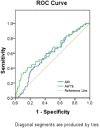A novel parameter is better than the AHI to assess nocturnal hypoxaemia and excessive daytime sleepiness in obstructive sleep apnoea
- PMID: 33633338
- PMCID: PMC7907378
- DOI: 10.1038/s41598-021-84239-0
A novel parameter is better than the AHI to assess nocturnal hypoxaemia and excessive daytime sleepiness in obstructive sleep apnoea
Abstract
To evaluate whether the percentage of total sleep time spent with apnoea and hypopnoea duration time (AHT%) is better than the apnoea-hypopnoea index (AHI) for the assessment of nocturnal hypoxaemia and excessive daytime sleepiness (EDS) in patients with obstructive sleep apnoea (OSA). Patients with suspected OSA were enrolled. Polysomnography, Epworth Sleepiness Scale, self-administered surveys and anthropometric measures were performed. The efficiency of AHT% and the AHI was evaluated for nocturnal hypoxaemia and EDS. A total of 160 eligible participants were analysed. The median AHT% in normal, mild, moderate and severe OSA patients was significantly different in the four-group patients with OSA. Spearman rank correlations analysis found that the associations were stronger between AHT% with percentage of total sleep time and O2 saturation of < 90% and minimum nocturnal oxygen saturation than these parameters with the AHI. AHT% had a greater area under the curve than the AHI for predicting EDS in patients with OSA. AHT% was significantly higher in the EDS group. We present a novel parameter, AHT%, to evaluate nocturnal hypoxaemia and EDS in OSA patients. AHT% partially compensates for the shortcomings of the AHI. AHT% is better than the AHI for assessing nocturnal hypoxaemia and EDS. AHT% reflects different clinical characteristics associated with OSA from a new perspective.
Conflict of interest statement
The authors declare no competing interests.
Figures


Similar articles
-
Apnoeic and Hypopnoeic Load in Obstructive Sleep Apnoea: Correlation with Epworth Sleepiness Scale.Ann Acad Med Singap. 2018 Jun;47(6):216-222. Ann Acad Med Singap. 2018. PMID: 30019066
-
Clinical Features and Contributing Factors of Excessive Daytime Sleepiness in Chinese Obstructive Sleep Apnea Patients: The Role of Comorbid Symptoms and Polysomnographic Variables.Can Respir J. 2019 Jul 10;2019:5476372. doi: 10.1155/2019/5476372. eCollection 2019. Can Respir J. 2019. PMID: 31360269 Free PMC article.
-
Epworth Sleepiness Scale may be an indicator for blood pressure profile and prevalence of coronary artery disease and cerebrovascular disease in patients with obstructive sleep apnea.Sleep Breath. 2012 Mar;16(1):31-40. doi: 10.1007/s11325-011-0481-5. Epub 2011 Jan 19. Sleep Breath. 2012. PMID: 21243439
-
Anti-inflammatory medications for obstructive sleep apnoea in children.Cochrane Database Syst Rev. 2020 Jan 17;1(1):CD007074. doi: 10.1002/14651858.CD007074.pub3. Cochrane Database Syst Rev. 2020. PMID: 31978261 Free PMC article.
-
Pulmonary hypertension in the obstructive sleep apnoea syndrome: prevalence, causes and therapeutic consequences.Eur Respir J. 1996 Apr;9(4):787-94. doi: 10.1183/09031936.96.09040787. Eur Respir J. 1996. PMID: 8726947 Review.
Cited by
-
Influencing Factors of Daytime Sleepiness in Patients with Obstructive Sleep Apnea Hypopnea Syndrome and Its Correlation with Pulse Oxygen Decline Rate.Evid Based Complement Alternat Med. 2021 Sep 13;2021:6345734. doi: 10.1155/2021/6345734. eCollection 2021. Evid Based Complement Alternat Med. 2021. Retraction in: Evid Based Complement Alternat Med. 2023 Jun 21;2023:9871041. doi: 10.1155/2023/9871041. PMID: 34552652 Free PMC article. Retracted.
-
Using Apnea-Hypopnea Duration per Hour to Predict Hypoxemia Among Patients with Obstructive Sleep Apnea.Nat Sci Sleep. 2024 Jun 20;16:847-853. doi: 10.2147/NSS.S452118. eCollection 2024. Nat Sci Sleep. 2024. PMID: 38915877 Free PMC article.
-
Cerebrovascular pathology mediates associations between hypoxemia during rapid eye movement sleep and medial temporal lobe structure and function in older adults.bioRxiv [Preprint]. 2024 Jan 28:2024.01.28.577469. doi: 10.1101/2024.01.28.577469. bioRxiv. 2024. PMID: 38328085 Free PMC article. Preprint.
-
Utilizing Envelope Analysis of a Nasal Pressure Signal for Sleep Apnea Severity Estimation.Diagnostics (Basel). 2023 May 17;13(10):1776. doi: 10.3390/diagnostics13101776. Diagnostics (Basel). 2023. PMID: 37238259 Free PMC article.
-
[A long-term ischemic stroke risk score model in patients aged 60 years and older with obstructive sleep apnea: a multicenter prospective cohort study].Nan Fang Yi Ke Da Xue Xue Bao. 2022 Mar 20;42(3):338-346. doi: 10.12122/j.issn.1673-4254.2022.03.04. Nan Fang Yi Ke Da Xue Xue Bao. 2022. PMID: 35426796 Free PMC article. Clinical Trial. Chinese.
References
Publication types
MeSH terms
Grants and funding
LinkOut - more resources
Full Text Sources
Other Literature Sources

